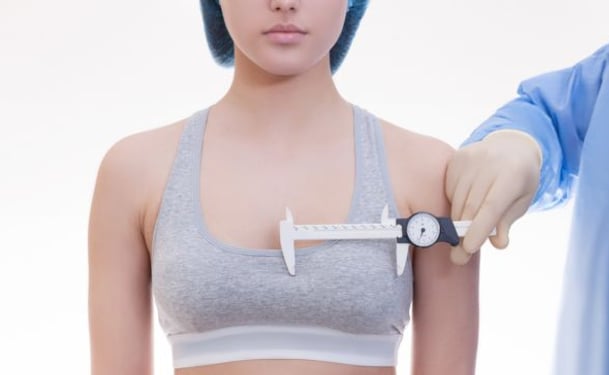Updated September 2018
When you go into your breast augmentation consultation with a cup size in mind, you run the risk of feeling deflated if that size goal doesn't exactly match up with your anatomy. Breast width diameter, or BWD, is arguably the most important measurement that will be taken and used to determine the implant sizes that work for your particular frame.
Understanding what breast width diameter is and how it is used to establish implant size, will help you to have realistic expectations and be comfortable knowing that you've chosen the best implant size.
What is breast width diameter (BWD)?
Breast width diameter (BWD) is the measurement of your breast width. Using a soft tape measure, your plastic surgeon will pull the tape tight, giving him a flat plane or straight line. Measurements are then taken from the cleavage to the outermost edge of the breast, near your arm.
Your breast width is measured in centimeters (cc's) and if you are like most women, this means your BWD will fall between 11 and 14 centimeters wide.

Preoperative measures include SSN:N (suprasternal notch to nipple), BW (breast width), BH (breast height), IMD (intermammary distance), and N:IMF (nipple to inframammary fold).
How BWD is used to select breast implant sizes
Once your breast width diameter is measured, your surgeon will present you with several breast implant sizes that work for you. A general rule of thumb when choosing the right breasty implant size is to use an implant that is within 1cm of your natural measurement. Stated more simply, it should be slightly narrower, if not the same width, as the width of your natural breast.
Of course, this can vary based on your individual anatomy. Natural factors in your anatomy that may change how a surgeon uses your BWD measurement are things like natural symmastia (tenting of the skin between the breasts), Poland’s Syndrome, pectus excavatum, and pectus carinatum.
Sample breast width diameter and implant size chart
Let’s use an example to work through how your BWD will affect implant selection by using a sample patient. The plastic surgeon measures a patient's BWD to be 12.5cm. During the consultation process, she discussed her desired look and size, even showing photos of the breast shapes she like best.
The surgeon recommends sizes for saline and silicone implants. Using the Mentor implant size chart, the surgeon gives her options for implant sizes in a moderate plus and high profile silicone, as well as a moderate profile saline implant. She can then try on sizers to determine the profile and cc size that she prefers on her body.
|
Sample patient |
12.5cm BWD |
Breast implant projection |
|
Mentor mod+ silicone, 300-400cc |
12.0-13cm width |
3.6-4.0cm projection |
|
Mentor HP silicone, 400-500cc |
12.3-13.2cm width |
5.1-5.4cm projection |
|
Mentor moderate saline, 325-475cc |
12.1-13.5cm width |
4.3-4.9cm projection |
The chart shows that there are several options! Not all of these options will be perfect, but one will be recommended for the result she is looking for based on her anatomy and desired look. You may notice that changing profiles from moderate plus to high profile allows her to go as low as 300cc or as high as 500cc implants. This is quite a variable range and will result in a visible size difference between these sizes.
The BWD measurement is, therefore, the guide to help determine the width needed and the cc size options available to each patient. Open discussion between you and your surgeon is essential when choosing what profile will result in the desired look.
Choosing a breast implant outside of your BWD
Despite what their BWD is telling them and their surgeon, some women choose to go outside of this measurement, either selecting an implant too small or too large. It often leads to patient dissatisfaction.
When you choose an implant that is too small or narrow, you lose the advantage of gaining cleavage and upper pole fullness. What you may end up with is a ball-in-a-sock look. On the other end of the spectrum, an implant that is too large or wide may result in your cleavage coming too close together—leaving your breasts looking as though they've merged into one (uniboob/symmastia)—or shifting too far apart and spilling into your armpits (lateral implant displacement).
Also, the weight of the implant can cause your breast tissue to thin, resulting in sagging breasts and/or the breast implant pushing through the tissue and finding a resting place in your inframammary fold (bottoming out). And if this isn't enough, with the tissue unable to fully cover the implant, visible ripples may appear on the surface of the breast skin.



